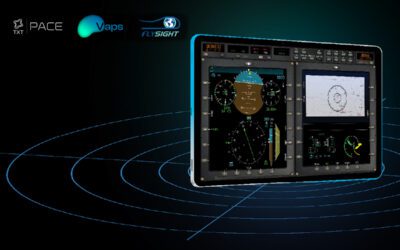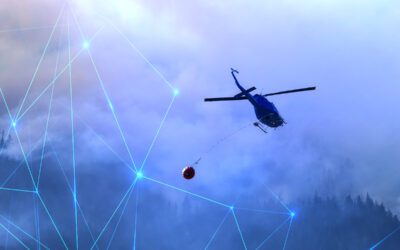A close look at integrated mission systems in helicopters and how they’ve evolved over time
If you’ve ever been inside a helicopter cockpit, you’ll know just how complicated these remarkable machines are. A helicopter dashboard in a modern aircraft has a mind-boggling array of controls, and flying a helicopter is said to be one of the most difficult things to learn. Over the years, integrated mission systems in helicopters have developed to take into account the advanced nature of helicopters, but also to ensure that pilots and operators are not so overwhelmed with information that they struggle to actually control the vehicle.
In this article, we’ll look at the development of the helicopter and how helicopter instruments have gone from relatively simple switches to advanced electronics that incorporate next-generation technology like Augmented Reality, heads-up displays, and Artificial Intelligence. We’ll examine how mission systems have been integrated into their layout and ensure that issues such as internalization do not compromise the efficiency or the effectiveness of airborne helicopter operations.
We’ll also look at the latest technology including OPENSIGHT Mission Console (mc) and how it’s pushing the development of mission systems in aerial units to the next level.
What is the role of the helicopter in military and civilian operations?
Helicopters have been an integral part of both military and civilian life since the 1950s. They made their first appearance in a theatre of war in the Korean conflict, acting as weapons platforms both on land and at sea. Because of the development of the turboshaft engine, helicopters were seen as one of the most viable operational platforms to launch from aircraft carriers for short-range missions.
As time went on, this multi-purpose vehicle has become more adaptive to a variety of roles including Search and Rescue as well as surveillance. The addition of advanced mission systems within the helicopter cockpit expanded the role of the aircraft, turning helicopters into effective SAR operations platforms, military and law enforcement vehicles, and civilian transport.
Today, those mission systems have moved to the next level, bringing such technologically advanced concepts as Augmented Reality, Virtual Reality, and real-time connectivity between airborne units and ground operations, including command centres. Helicopters are now fully integrated into both military and civilian roles, thanks to the incorporation of miniaturised systems and ‘plug-in’ components.
The history of helicopters
From the moment Leonardo da Vinci contemplated the idea of a ‘hovering machine’, helicopters have been part of our history. The development of an engine that operated horizontally spinning rotors to provide lift and thrust made that Renaissance idea become a reality in the 1940s when Sikorsky’s R-4 became the first helicopter to go into full-scale operation. Once the practicalities of vertical flight had been tackled, the advancement of helicopter designs, including their mission consoles, moved forward in leaps and bounds.
Rotor aircraft come in a wide variety of formats, with the most common operating with a single main rotor. To prevent the vehicle from spinning out of control, a vertical anti-torque rotor is deployed at the tail end, giving the helicopter greater stability and manoeuvrability.
Dual-rotor helicopters such as the twin-bladed Chinook or larger dual-rotor craft such as the Sikorsky S92 or the MH65 and the Westland AW189 also feature in military operations and for land and sea SAR organisations such as the Coastguard Service. These are usually much larger and heavier vehicles designed to carry bigger payloads or more operational personnel quickly and effectively into hostile environments, or to retrieve casualties in dangerous situations such as shipwrecks or natural disasters.
The next generation of helicopters
The modern helicopter is a highly refined and complex machine that plays a unique role in aviation. With the ability to take off vertically, hover, and fly both forwards and backward, it mimics the flight of a hoverfly or dragonfly, apparently defying the usual laws of aerodynamics. However, careful engineering has ensured that the all-important airflow through the rotors, and that essential anti-torque stability factor, have resulted in modern helicopters that are incredibly agile, and in the case of helicopter gunships like the truly awesome Apache, remarkably fast.
The flexibility in the rotor blades helps to control the aerodynamic forces that act on the rotor, allowing the pitch of each blade to be altered to ‘fine-tune’ the helicopter’s manoeuvring capabilities. Thrust is generated by the lift forces created by the spinning blades. The craft can hover thanks to the ability of the craft to accelerate a large mass of air at a relatively low velocity, which is why the craft’s rotor blades are so large. If a craft were to attempt the same operation with shorter blades, the amount of power required to hover and even lift the aircraft off the ground would be colossal and unsustainable for any length of time.
The skill of a helicopter pilot is second to none. The modern helicopter dashboard is one of the most complex in aviation and requires the pilot and crew to multi-task constantly. As technology has advanced, the variety of equipment carried by a helicopter has increased exponentially. Interestingly, we have now reached a point in helicopter evolution where we’re asking the question, “Is there too much tech in a helicopter cockpit?”.
Integrating more advanced technology – how much is too much?
While the basic helicopter instruments for controlling the manoeuvrability of an aircraft haven’t changed much in the last few years, what has altered is the amount of additional equipment that helicopters now carry. Thanks to miniaturisation and the development of surface-mounted electronic components, advanced software and a drive towards more compatible equipment, both military and civilian craft can now carry a plethora of technology. This includes multi and hyperspectral imaging equipment and cameras, Augmented Reality and even AI.
The issue, however, is not if the technology can perform correctly, but what additional pressure it puts on the pilot and crew. Mission systems need to be ‘user-friendly’ and intuitive. Adding more logistical challenges into an already complex environment can quickly lead to operator fatigue.
So there is an important issue concerning how specific components evolve over time, and how intuitive they are to use in conjunction with existing technology. For example, the addition of Augmented Reality should complement rather than compete with the technology the operator is already familiar with. Ease of use and the ability to communicate real-time information quickly and accurately is crucial to mission success.
Mission systems also have to be able to link airborne and ground-based units so that real-time operational data can be shared. This is particularly relevant in military operations and in SAR with time-critical parameters. If the data is too complex or too internalized, it can lead to a loss of quality if the operator is trying to manage too many operations at once. Clarity, ease of data transference and, most importantly, mission relevance are the aims of any modern helicopter dashboard mission system.
The requirement for mission system technology to be easy to upgrade is also fundamental, as the advancements of systems such as geospatial software solutions and AR synthetic information layers are constantly being updated. Hand in hand with this goes a requirement to make these upgrades easy to manipulate and customize. For example, the requirements of an airborne SAR platform will be very different from those of a reconnaissance aircraft or covert military operations system.
It’s this fundamental requirement for a turnkey solution that can be manipulated to fit the exact parameters of the user that represent the evolution of helicopter instruments. As we said earlier – the fundamentals such as rotors and fuselage layouts have reached their optimum design level. What evolves now is the interior of the helicopter cockpit, and the interaction between technology and the operators, both in the aircraft and on the ground.
So in response to “How much technology is too much?”, the reply is that as long as the solutions are integrated in such a way that there is no loss of quality, and that the technology can be used easily and intuitive by any airborne operator, then the more the merrier!
The benefits of an advanced helicopter integrated mission console
The key benefit of an advanced helicopter integrated mission console is that it is grandfathered into an existing system that the operator is already familiar with. These consoles are the very definition of ‘augmentation’ in that they complement and enhance the existing console with multi-layered programmes to give a more complete data set.
From operational information on the aircraft itself to heads-up displays showing the pilot the location of hazards such as overhead power cables, integrated mission consoles represent the next step in the evolution of helicopter cockpits.
The clarity with which the various components of an integrated mission console interact with one another and with the user is also a major factor. There is also the necessity to avoid continually swapping from one moving map to another. Augmented reality allows the system to overlay multiple information layers, building up a multi-dimensional map of the target area. This improves mission effectiveness and can be crucial in life-saving operations.
For example, the overlay of a multi-spectral camera on top of a 3D rendering of the terrain can provide vital clues to pinpoint casualties. The area covered in one sweep can also be enlarged, saving time and resources and again, potentially shaving time off that window of opportunity during a rescue operation.
For surveillance operations, a single target can be identified and tracked without constantly changing from one programme to another, reducing the risk of losing the target in a complex urban setting. The ability of AR to integrate multiple high-resolution video flows that can be relayed back to command centres in real-time also improves the chances of mission success.
What is an integrated mission system in Avionics?
Bespoke, turnkey solutions are the way forward when it comes to integrated mission systems in helicopter cockpits. Instrumentation miniaturization has made it possible to bring online a host of next-generation technology such as hyperspectral imaging sensors.
An integrated mission system should be a hub for real-time and pre-programmed information collation and distribution, including video processing algorithms that can enhance images, giving the operators the ability to peer through foggy conditions as if it were a clear day, as well as image stabilisation and super-resolution.
A system such as OPENSIGHT’s turnkey Mission Console also includes highly advanced systems and access to databases, including a geodatabase for direct geocoding on the move. Other key elements that can be a major benefit in operations include automatic target detection and classification. This AI-enhanced system allows users to eliminate ‘background noise’ to pinpoint a target with accuracy, even if they’re mobile.
Touchscreen technology has gone a long way towards making updated mission console systems more user-friendly. We’re all familiar with the concept of touchscreen technology, and in a mobile environment, it makes it far easier for operators to access various aspects of the system quickly and easily. Touchscreen technology also reduces the amount of additional hardware an airborne unit or naval unit has to carry, reducing weight and improving the aircraft’s fuel efficiency which in turn allows it to extend its mission time.
All of these factors produce a more intuitive and responsive system that can be easily controlled by operators, as well as smoothing the flow of real-time information between operational units and command centres.
FlySight Mission Console – the future of helicopter dashboard development
It’s systems such as OPENSIGHT-mc that are leading the way for the next generation of military, civilian, law enforcement and SAR helicopters. The most important element of these mission systems is that they are customizable. To prevent the ‘too much information’ dilemma, they provide operators with data only when it is needed, minimising the issue of informational quality degradation. They allow the operator to focus on the mission itself, rather than scrolling through endless menus to select the correct maps or overlays.
The transference of data and the ability to relay geospatial details in real-time is critical for situations where the mission parameters are more fluid, such as in SAR and active surveillance operations. The improved accuracy also allows airborne units to coordinate with ground-based operators or respond to updated search parameters provided by command centres.
But it’s the flexibility and user-friendliness of OPENSIGH-mc that makes it such an advance in the evolution of helicopter instruments. And it is this direction that we believe will determine how helicopter cockpits and dashboards are designed in the future, based on the input of the end-users themselves.
The fundamental controls of a helicopter may not change, but the advancement of AR, AI and turnkey technological solutions for mission systems will enable the helicopter of the future to achieve so much more.
To find out more about the OPENSIGHT Mission Console system, explore our interactive site where you’ll find technical information and demonstrations of the system in action.
📎Discover our success stories and get who has integrated our mission console yet: Resources – FlySight





